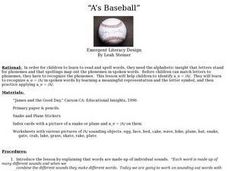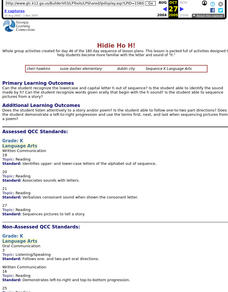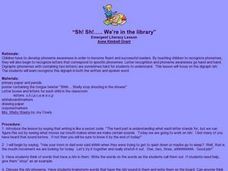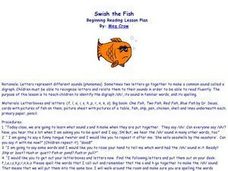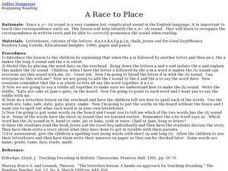Curated OER
Phonics on the Farm
In these eight recognizing the phonetic sounds in picture words worksheet, students observe pictures of farm animals and color the ones that have the specified /c/ , /d/, /p/, /h/, /m/, /g/, /sh/, or /ch/ sounds. There are five pictures...
Curated OER
A's Baseball
First graders distinguish between short vowel a and long vowel a. They are introduced to the vowel-consonant-e pattern that changes short vowel sounds into long vowel sounds. They practice reading words with the vowel-consonant-e pattern.
Curated OER
Hidie Ho H!
Students become more familiar with the letter and sound of h by using the poem, Humpty Dumpty. They are given a sequencing sheet, a pair of scissors, crayons, and a piece of construction paper and told to put pictures in the correct order.
Curated OER
Sh! Sh! We're in the Library
Young scholars focus on the diagraph of sh. They recognize this in both the written and spoken word. To introduce this instructional activity, the teacher asks if anyone's mom or dad has told them shhhh, when they were trying to get...
Curated OER
Swish the Fish
Pupils study the /sh/ phoneme by making the sound, and reciting a tongue twister. Next, they make words that the teacher models using their Elkonin letterboxes. While using the big book version of Dr. Seuss', One Fish, Two Fish, Red...
Curated OER
Buh Bee and Duh Dee
Students differentiate between /b/ and /d/ in both written and spoken words. They listen to the /buh/ and /duh/ sounds in words, a tongue twister, and in Audrey Wood's, Silly Sally. They recite the tongue twister before writing /b/ and...
Curated OER
Say Aaaaa for Apple
Students say words by blending sounds and phonemes. They decode words in order to read and identify and understand the letter a. This phoneme /a/ is one of the short vowels that are needed to read and write. They will show example of...
Curated OER
Alphabet Books
Students explore alphabetic principle and phonemic awareness by making alphabet books. They identify initial consonant sounds and choose pictures of objects that begin with given letters of the alphabet. Students identify phonemes...
Curated OER
Sound Stretching
In this basic vowel and consonant blending lesson, young learners are shown how to "blend" the sounds of different letters together in order to make a word. Simple words such as, "sun," "moon," and, "ant," are used in a whole-class setting.
Curated OER
A Race to Place
Students distinguish between short vowel a and long vowel a. They are introduced to the vowel-consonant-e pattern that changes short vowel sounds into long vowel sounds. They practice spelling words with the vowel-consonant-e pattern.
Curated OER
Spinning Short Vowel Game
First graders, in pairs, use spinners to experiment with different combinations of letters. They combine letters and determine whether they have produced a word or not. They construct and record words choosing letters from designated tiles.
Curated OER
Shiny Shells on the Shore
Learners investigate how: A single phoneme, which is a vocal gesture in spoken words, can be represented by more than one grapheme. Also how a digraph is the combination of two letters that make one sound (there are both vowel and...
Curated OER
O-o-o-oh, no-o-o-o!!
Pupils engage in an emergent literacy activity in order to practice the skill of phonemic awareness. They learn this skill using the phoneme for the letter "o". Students must recognize the letter as well as its sound.
Curated OER
English Exercises: The Alphabet Song
For this alphabet worksheet, learners complete an online interactive activity pertaining to alphabetical order, initial consonants and alphabet letters. Students may listen and watch a clip of the alphabet song.
Curated OER
Reading Recall
Second graders review the vowe-consonant-e pattern in association with reading fluently. After identifying the changes made to a phoneme when the letter e is added at the end of the word, 2nd graders practice reading a phonetically...
Curated OER
---uck Word Family
In this --uck word family worksheet, students add the ending "--uck" to six consonant beginnings to form new words. All words are inside a truck shape.
Curated OER
A Gift for Charlie's Mum-- Ch Words
In this language arts worksheet, students learn about "ch" words by reading a 1 page story and answering 15 questions. This page is from the UK.
Curated OER
Here Comes the Choo Chooooooo!!
Students practice exercising the phoneme/digraph that makes the /ch/ sound. They drill on the tongue twister, "Charles chatted while he waited on his chance to win a check," and encounter Elkonin boxes along with the book, "Chad Checks,"...
Curated OER
Use Digital Photos of Scary Things to Inspire Poetry Writing
There's nothing like a provocative image to inspire a creative writing session. In the language arts instructional activity presented here, middle schoolers bring in digital photos of scary objects, such as a big spider, or a hornet's...
Curated OER
Nouns and Articles
Here is a 114-slide PowerPoint that covers the proper use of articles, singular and plural nouns, and rules of capitalization. Your students should gain valuable practice from working through the examples present in the slides. This is...
Houghton Mifflin Harcourt
Family and Friends: Extra Support Lessons (Theme 4)
Family and Friends is the theme of a unit offering extra support lessons. Follow each lesson plan's teach, blend, guided practice or practice/apply routine to reinforce concepts such as clusters, responding to reading, drawing...
Balanced Assessment
Dog Tags
Class members demonstrate a proficiency with conditional probabilities through this task. Individuals calculate probabilities using multiplication and addition. They also distinguish between repetition and non-repetition while...
Curated OER
Double Jeopardy-Homophones
Second graders identify homophones as words that sound alike but have different meanings. They, given a pair of homophones, are to explain the meanings of the words using gestures, role playing, or drawing a picture with their partner.
Poetry4kids
Alliteration and Assonance Lesson Plan
Scholars analyze the poem My Puppy Punched Me in the Eye by Ken Nesbitt in order to locate examples of alliteration and assonance. After reading the poem, alliterative words are underlined and assonant words are circled.

